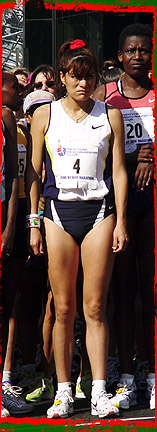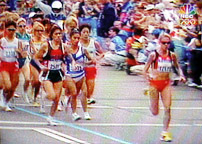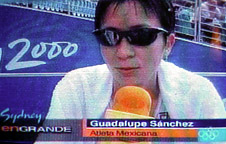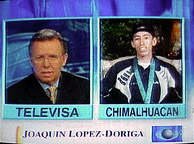Running in Mexico

Adriana Fernández (Mexico)
at the NYRRC Women's 10K, 2000
(photo credit: Roland Soong) |
Of the athletic sports, perhaps
the one that captures the imagination is the marathon. This is a
sport that demands something extraordinary --- a 100m meter sprint is like
hurrying to catch a bus, but a 26.2 mile run is not daily routine.
This is also a sport that rewards hard work above talent --- it is
impossible to even complete the distance without a serious commitment to
training.
The country of Mexico has produced a number of famous
marathoners
- Dionisio Ceron won the prestigious London Marathon
three years in a row (1994 in 2:08:53, 1995 in 2:08:30 and 1996 in
2:10:00)
- Andres Espinosa was second at the Boston Marathon in
1994 by just 4 seconds. His time of 2:07:19 in that race is the
current Mexican national record
- The best finishing places by Mexicans in the Olympic
marathon is German Silva in fifth place at Atlanta and Rodolfo Gomez
in sixth place at Moscow.
In the famous New York City Marathon,
- Salvador Garcia became the first Mexican winner of
this race in 1991 with a winning time of 2:09:28. Fellow
countrymen Andres Espinosa placed second; and Isidro Rico took fifth
in the same race.
- In 1993, after finishing second in the two preceding
years, Andres Espinosa took first place in a time of 2:10:04.
Months before the race, Espinosa had replaced the Volkswagen symbol on
his Jetta with a Mercedes-Benz ornament, representing the spoils of a
New York City victory. Then he went to a forest near Mexico City to
train at altitude (9,000 feet to be exact).
- In 1994, the race was reduced down to two Mexicans
near the end, German Silva and Benjamin Paredes on a hot day.
Near disaster struck when German Silva followed a police escort
vehicle and took a wrong turn off the course. Fortunately, he
recovered and won in a time of 2:11:21. Silva grew up without
running water or electricity on an orange farm in Mexico's steamy
Veracruz state where he ran to school everyday. According to
family legend, Silva took up running after the family mule pitched him
off its back one day instead of getting him to class on time.
When asked by the Mexican president what he wished for, Silva asked
for electricity for his tiny village of Tecomate.
- In 1995, in 42-degree weather and windchills, German
Silva still ran nearly the same race. He had a competitor at his side
most of the way, not distancing himself from Englishman Paul Evans
until nearly the 25-mile mark. At that point, Silva sprinted hard and
won in 2:11:00 to repeat as the winner.
- Perhaps the most memorable Mexican male runner is
someone who did not win the race. In 1982, Rodolfo Gomez dueled
with the American Alberto Salazar all the way to the end, to finish
just 4 seconds behind in 2:09:33. That memorable race coincided with the
rise of the marathon as a competitive sport as well as a mass
participation phenomenon. At the awards ceremony that evening,
Gomez spoke in Spanish, at length and with passion. The only available
translator was Salazar's Cuban-born father, José, who simply informed
the audience, "Rodolfo says he loves New York, and he loves
Alberto." Gomez would go on to become an influential
running coach.
|
What does it take to become a world-class marathoner?
Here is the description of German Silva's training program:
While many world-class runners work out near Boulder, Colo.,
where elevations range from 5,800 to 10,000 feet, the volcano where Silva and
his teammates train - Nevado de Toluca - is higher still. The volcano, known
as Xinantecatl in the native Nahuatl tongue, rises to 15,387 feet at its peak,
making it Mexico's fourth-highest mountain. The weather surrounding it is a
study in contrasts - almost always blisteringly hot at the bottom and frigid
year-round at the top.
At those altitudes, a flatlander in marathon shape sees
white flashes before his eyes while training. Some runners sleep on their
backs at such heights because breathing is too laborious on their stomachs.
Silva and his running partners seek the pain that comes with
the altitude. They live for up to a week at a time at a hostel on the mountain
at 12,300 feet. Every morning, their feet pound against the sinuous,
boulder-strewn paths. Every evening they return in subfreezing temperatures to
the hostel, which has no heat, electricity or running water.
In between there are no showers, only a change into fresh
running clothes, hasty meals of tortillas and beans and time to think about
the training regimen ahead - another day's run up to the crater of the
volcano, a second run along a plateau to a volcanic lake, and when the day or
week is out, a run down the stark mountain.
"It's a place of suffering, more than anything. ... But
doing it proves to yourself that you are prepared to endure a lack of comfort
in order to be more, to become more,'' Silva said.
"It is a place you have to understand and have respect
for. Running it is so hard that every race seems easy in comparison. For me,
it gives me strength.''



Adriana Fernández in the women's marathon at the 2000 Sydney Olympics
In 1999, Adriana
Fernández became the first Mexican woman to win the New York City
Marathon in a time of 2:25:06 in a dominant performance by taking charge on a
windy day and kept building her lead. It would come as no surprise that
she is coached by Rodolfo Gomez, trains at the Nevada de Toluca volcano and also
at the Desierto de los Leones. What does a victory in the New York City
Marathon mean? Here is what happened immediately to Adrianna afterwards:
- featured on the front page of the largest New York City Spanish-language
newspaper, "El Diario", which filled its front page with a photo of
her breaking the finish line tape, the headline "Viva Mexico,"
and the subhead "Adriana Fernández
gana la Maratón de NY." Inside, the paper declared
"Orgullo Latino"
- three early morning television
appearances, including CBS' "Early Show"
- a tour of the New York Stock
Exchange where she rang the opening bell
- two promotional appearances for race sponsors
- a trip to City Hall where they were given the keys to the city by
Mayor Rudolph Giuliani
- an appearance on the "David Letterman Show"
- a press conference with the media
- two long interviews with Spanish-language TV networks, which
aired the programs not only in Mexico but throughout Latin America
- the Mexican consulate held a dinner in her honor.
"I enjoy going to all these events, but it does take away from your
concentration (from training)," she said. Fernández began running in
a Mexico City park at age 15 to keep company with her father Daniel, a former
amateur boxer, who told her that she needed to get fit and lose some
weight. She slowly realized she had the talent to go far but still
continued her studies to become a lawyer. Fernández completed a five-year
program in civil rights law after high school and graduating in 1994 before
abandoning law in favor of a professional running career.
In the aftermath of her New York triumph, "there are many
more women running in Mexico now,'' she says. "They need more time for you
to see them'' at the world class level, "but they will develop. This
is going to encourage more women to run," she predicts. "The
competition is going to be much stronger." Her coach, Rodolfo Gomez,
concurred. "This will change the mentality of Mexican women. Most are
counting on marriage and after that, nothing else. Maybe this will tell them
they can do something better than the men."

Ana Guevara, 400m finalist
at Sydney Olympics 2000 |

Joel Sanchez, bronze medallist
50K race walker at Sydney Olympics 2000 |

Guadalupe Sanchez, 20K racewalker
at Sydney Olympics 2000 |
But the strength of a country lies not in one or two ephemeral
individuals. Excellence in international sports competition is usually
built on top of mass grassroots participation. We will now cite some data
from the TGI Mexico study. This is a survey of 11,040 respondents
between the ages of 12 and 64 years old conducted by Moctezuma y Asociados in
1999-2000. According to this study, 2.4% of the respondents said that they
practiced athletics in the past 12 months. Here, the term 'athletics'
including running of all forms and distances. The following table shows
the geodemographic breakdown:
| Geodemographic Class |
% practiced athletics |
Geographical region
Mexico City
Guadalajara
Monterrey
Balance of Mexico |
3.0%
1.5%
1.6%
2.1% |
Socio-economic Level
AB
C+
C
D+
D/E |
3.5%
2.8%
3.6%
2.3%
1.4% |
Age/Sex
Male 12-19
Male 20-24
Male 25-34
Male 35-44
Male 45-54
Male 55-64
Female 12-19
Female 20-24
Female 25-34
Female 35-44
Female 45-54
Female 55-64 |
3.9%
3.9%
1.5%
5.0%
2.4%
1.3%
4.0%
1.2%
1.1%
0.9%
1.7%
0.0% |
(source: TGI Mexico, Moctezuma y
Asociados)
Among those who practiced athletics, 72% said that they either
completely agree or somewhat agree with the statement "I make sure that I
exercise regularly" compared to 41% in the general population.
|

The most hated man in Mexico ---
the official who disqualified racewalkers
at the 2000 Sydney Olympics
|

Noé Hérnandez being interviewed
Joaquín López-Dóriga
on the Televisa network
|

Noé Hérnandez,
silver medallist in the 20K racewalk,
2000 Sydney Olympics
|
A sport can be made more popular through mass and
continuous exposure. According to the TGI Mexico study, only 0.3%
of the people have attended a live athletic event in the past 12 months.
At this time, there are simply not many track meets or road races being held in
Mexico. Among those who practiced athletics, live attendance rises up to
25.4%.
According to the same study, 2.7% of the people
have watched an athletic event on television in the past 12 months. We
should point out that this survey was completed before the 2000 Sydney Olympics,
in which Mexican race walkers had their usual share of good performances.
Among those who practiced athletics, the television viewing incidence rises up
to 15.2%.
Commercially, the TGI Mexico Study reports that
7.9% of the people have purchased one or more pairs of running shoes in the past
12 months. Among those who practiced athletics, 42.0% have purchased
running shoes. The athletic shoe market is currently dominated by the
global brands: adidas (27%), Nike (26% share) and Reebok (16%).

WWW LINKS
MARATHON STORIES
- A
Brief Chat with German Silva Peter Gambaccini, in Runner's
World, October 29, 1997
- Altitude
training gives Mexico's German Silva high hopes The
News-Times, July 12, 1996
- An
Interview with Adriana Fernandez ASAPSports Fast Scripts,
November 7, 1999
- Celebration
Continues for Marathon Winners. CNN/SI, November 8, 1999
- Fernandez
Out To Prove Her Again Yahoo! News, November 3, 2000
- Fernandez's
New York City triumph makes her the pride of Mexico Women's
Running, week of November 15, 1999
- Not
A Fluke: Fernandez proves that she's here to stay CNN/SI,
November 9, 1999
- The
Volcano Runners ****
Outside Magazine, November 1996
(posted by Roland Soong on 11/10/00)
(Return to Zona Latina's Home Page)









